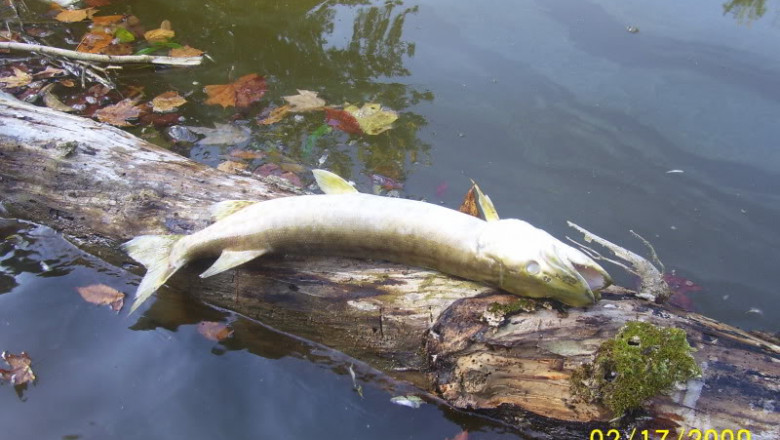The headwaters of Dunkard Creek come together upstream of Brave, Pennsylvania, a hamlet of 412 people in Greene County. From there, the creek – once teeming with more than 161 aquatic species ranging from freshwater mussels to 3-foot muskellunge -- winds 43 miles to the Monongahela. On September 4, 2009, dead fish began collecting in a pool below the Lower Brave Dam. Over the next week, fish floated to the surface, sank to the bottom, and washed up on the banks along the entire length of the creek. By the end of the month, almost everything in Dunkard Creek was dead. The only exception was an invasive microscopic alga—common in Texas estuaries—that had somehow migrated into the creek and now thrived in its suddenly brackish water.
This fish kill happened to coincide with the initial rush to develop the Marcellus Shale in Pennsylvania as natural gas prices spiked to record high levels. Drilling companies were drawing down water levels at local tributaries, including Dunkard Creek, with larger tankers. They were also disposing of brine and other waste by hauling it to sewage treatment plants that were unequipped to handle it downstream on the Monongahela River.
Dunkard Creek is one of the many issues explored in my book, Under the Surface.
In a recent review, Bill McKibben cited my depiction of the fish kill as an example of the ecological stakes of shale gas development. Early this month, former DEP Secretary John Hanger criticized McKibben’s characterization as a “false narrative” that lead to polarization of the shale gas debate. Hanger’s assessment has been held up by the industry, which insists that Dunkard Creek portrayal comes from skewed and erroneous media reports that unfairly suggest the industry was involved in the disaster.
There has been confusion over the cause of the factors that lead to the fish kill in Dunkard Creek, and the gas industry has used this confusion to deflect accountability for its role.
The catalyst for the disaster, according to an assessment from the Pennsylvania state DEP and the federal EPA, was a coal mine operated by Consol Energy that had been granted variances for discharges with high TDS concentrations. TDS (total dissolved solids) is a measurement of chlorides and other elements, which in the summer of 2009 tipped the chemistry of Dunkard Creek beyond its ecological threshold.
Somehow, the industry likes to ignore the fact that in addition to the mine discharge, which had been legally allowed for years, there were instances of illegal dumping by a drilling waste hauler for a period leading up to the fish kill; that low water levels contributed to the impact of the disaster; or that the foreign algae that thrived in the brackish water and robbed oxygen from the freshwater species was indigenous to the same place where the drilling equipment originated -- Texas. Failure to acknowledge any of these facts is the most recent example of the industry’s way of portraying environmental impacts related to full scale shale gas development: If they are not black, they must be white. The Dunkard creek disaster is neither of these, but these aspects are pretty straight forward:
The EPA has determined that a contributing factor was low water levels in the Creek due to the industry’s water withdrawals to supply hydraulic fracturing.
The organism that infected the creek ---Prymnesium Parvum (Golden Algae)---was not a local phenomenon, or a product of the mine discharge, but an import that hitched a ride from a place where it thrived in coastal estuaries.
In addition to the mine discharge, illegal dumping of drilling wastewater has been identified as a suspect at several locations, including a brine disposal well, called Morris Run. This well had come under scrutiny for lax security and possible environmental problems. In 2009, the EPA fined Consol Energy, the owner of the well, $158,000 for failing to keep gates locked or to properly log the trucks coming and going from the site. This February, Alan Shipman, who hauled waste for the drilling industry, pleaded guilty to 13 of 98 charges that he illegally dumped millions of gallons of wastewater in different Pennsylvania counties over the last six years.
The plea bargain came after authorities accused Shipman of dumping drilling waste into Morris Run, other tributaries of Dunkard Creek, as well as other Pennsylvania watersheds from 2003 to 2009.
I raise these facts now because the story of Dunkard Creek is being written by the industry as something less than it really was. If you examine the story of Dunkard Creek from all relevant sources, as I have, rather than the industry’s obfuscation of the event, you will find a record that shows more at play than simply a discharge from a recalcitrant mine operation, and these other factors are fair points of discussion when looking at the impact of shale gas development. At some point, the industry may realize that the way to build credibility and public favor is to take accountability for problems and work to make improvements, rather than to point the finger at others and throw up a veil of blamelessness.

